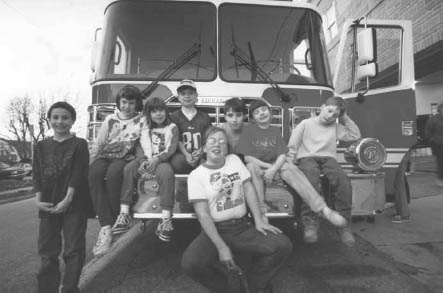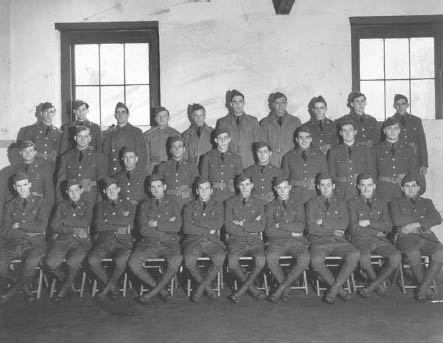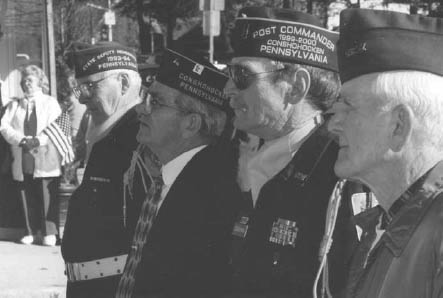Remembering Conshohocken and West Conshohocken (12 page)
Read Remembering Conshohocken and West Conshohocken Online
Authors: Jack Coll

Conshohocken Fire Company No. 2 never stopped growing, as it continued to purchase top-of-the-line equipment. It didn't hurt that in the early years, fire company officials worked with E.J. Wendell, and Charles Young, co-founders of the Hale Fire Pump Company. No. 2 has a long history with Hale Products.
In 1943, the No. 2 purchased the Uptown Social Club building, a one-story building adjoining the firehouse at Ninth Avenue and Harry Street. This allowed company officials to expand the firehouse. In 1947, the company purchased the property of John Hamilton at 819 Fayette Street for the purpose of erecting a handsome new firehouse with the main entrance on Fayette Street.
For reasons unknown, the fire company never built its headquarters at 819 Fayette Street, but more than fifty-five years later, the company again purchased a Fayette Street property. In 2003, ribbon-cutting ceremonies were held for the new firehouse. In 2010, Conshohocken Fire Company No. 2 set a new standard in firefighting when the membership elected Jackie Pierce as the first female president of a fire company in the borough. Pierce had been an active firefighter in the company for many years before being elevated to president.

Future firemen and firewomen take a break at the Conshohocken Fire Company No. 2 in 1999. Today, a few of these youngsters are firemen at No. 2.
Seated, from left
: Brandon Mungon, Amy Costello, Rachel Hoagan, Danny Costello, Nicki Hogan, Matthew Costello, Elizabeth Costello and Mark Costello.
ONSHOHOCKEN
M
ILITARY
It Was a Civil War
When John Brown raided Harpers Ferry in 1859, history states that he set in motion events that led directly to the outbreak of the Civil War in 1861. While the war might have begun in South Carolina on April 12, 1861, the widespread effects of the war reached clear across the country, into Conshohocken and beyond.
Men from the Conshohocken community and surrounding areas joined the war effort and served in the Pennsylvania Eighty-eighth Division, Company C, out of the Spring Mill section of Conshohocken. Before the war ended in 1865, a total of 200,000 Americans were killed in action and a total of more than 600,000 Americans lay dead from war-related wounds and disease.
Dr. David Richardson Beaver served Conshohocken as the town physician for fifty-nine years before passing away in 1923. Dr. Beaver served as an assistant surgeon in the Civil War from April 13, 1864, until June 11, 1864, in the Pennsylvania volunteers and also as a first assistant surgeon of the 191
st
Regiment. Beaver served with Grant's army until the capture of Lee, after which he was ordered to Harrisburg and mustered out of service in July 1865. Dr. Beaver served in the Battles of the Wilderness, Laurel Hill, Bethesda Church, Spotsylvania Court House, North Anna, Cold Harbor, Peebles Farm, Weldon Railroad and Petersburg.
In 1870, Dr. Beaver came to Conshohocken as an assistant to Dr. John K. Read and purchased a house at 405 Fayette Street, where he lived until his death. He later set up his office next door at 401 Fayette Street, currently the site of the 401 Diner. His daughter Margaret and son-in-law Stuart Maloney later moved into his house and lived there until the late 1940s.
Ebenezer Lancaster was a Conshohocken native and a member of Company E of the Fifteenth Pennsylvania Cavalry. He enlisted on August 22, 1862, and died in Nashville, Tennessee, a year later. John Pugh was a lifelong resident of the borough who served several years during the war. Pugh later became the president of Conshohocken's First National Bank and owner of the S&J Pugh Feed Business once located at the foot of the Matsonford Bridge.
Thomas H. Ramsey lived most of his life in the Spring Mill section of Conshohocken, and when the Civil War broke out, Ramsey answered President Lincoln's first call for volunteers. He enlisted in the 138
th
Regiment Pennsylvania and served through the entire war. He was in the campaign in the Wilderness and was wounded at Chancellorsville. He was also in numerous battles and marched with Sherman to the sea.
John Baker posted a brilliant war record. He was captured at the Battle of Chancellorsville and returned to Conshohocken, taking part in the hotel business for many years following the war. Jonathan Rogers and William McFeeters, both members of the 88
th
Pennsylvania Volunteers and lifelong residents of the borough, played a part in Conshohocken's effort in the war. John J. Murphy was a member of Company G, 114
th
Regiment, and served three full years, fighting in the Battles of Fredericksburg, Chambersburg and Gettysburg. James Palmer, George W. Keys, George Pitman, John Bemesderfer, Robert Herron, Nathan Jones and Jonathan Rogers were a few of the dozens of Conshohocken residents who lived and worked in the borough before, during or after the Civil War. Three Conshohocken volunteers were killed in action, fifteen were wounded and two were taken prisoners of war and released.
The borough of Conshohocken holds a very unique designation that no other community in America can claim title to. During World War I, the borough of Conshohocken sent more men and women off to serve in the United States military than any other community in America per capita. Robert Bell, Louis Bickings, Harry Dembowski, Daniel Donovan, Francis DeMario, Harry Wertz, John Wood, Samuel Gordon Smyth, Frank Hitner, George Hastings, James Koch and George Rodenbaugh were among the hundreds of Conshohocken residents who went off to war between 1916 and 1918.
Shortly after the signing of the Armistice at Complegne, France, that brought a close to World War I on November 11, 1918, the United States Congress recognized Conshohocken's efforts during the war. A merchant marine ship was named the
Conshohocken
in honor of the town's war service. The SS
Conshohocken
was launched on January 31, 1920, from the Sun Ship Yard and was christened by Mrs. Geoffrey Creyke, wife of the assistant to the vice-president of the Emergency Fleet Corporation.
The SS
Conshohocken
was an eleven-thousand-ton cargo carrier and was the last of the series of ships built under the supervision of the Emergency Fleet Corporation and the twenty-third ship to be launched at the yards of the Sunbuilding Company in Chester, Pennsylvania.
January 21, 1941, was a mild, sunny day as eighty-eight members of Battery C lined up outside their headquarters located at 918 Maple Street. The soldiers marched up Ninth Avenue to Fayette Street, and a parade led by Betty Colburn, a drum majorette, and the Conshohocken High School Band marched down Fayette Street toward the train station, with a crowd of thousands of residents and schoolchildren cheering them on.
Conshohocken's Battery C mustered into the Pennsylvania National Guard on October 28, 1940, more than a year before the United States became involved in World War II. Battery C of the 1
st
Howitzer Battalion of the 166
th
Artillery left the Conshohocken train station for Camp Shelby, Mississippi, and didn't return for five years.
The men spent two years in Mississippi and then went to Camp Blanding in Florida and later to Fort Gordon and finally to Fort Dix in New Jersey. Once the men of Battery C left the States, they headed to North Africa, crossed the Mediterranean Sea to Italy and then engaged in some of the worst fighting of the war. Battery C moved on to southern France, arriving on D-Day, August 15, 1944. The men later went on to Germany and Austria before the war finally ended.

A few of the eighty-eight-member Battery C of Conshohocken pose for a group photograph at their headquarters, once located at 918 Maple Street, before marching off to war on January 21, 1941. Battery C mustered into the Pennsylvania National Guard on October 28, 1940. Battery C of the 1
st
Howitzer Battalion of the 166
th
Artillery left the Conshohocken train station for Camp Shelby, Mississippi, in 1941 and didn't return for five years.
Perhaps one of the highlights for the men of Battery C was their part in taking out the Bridge on the Rhine. Battery C was part of the 938
th
Field Artillery's C Battery and Company A of the 630
th
Tank Destroyers. After more than six hours of heavy fire, the bridge went down. The west span had been blown from its main support and was a twisted heap of steel littering the river below.
By July 1945, after fifty-six months, the final members of Battery C returned home; 12 members of the unit lost their lives during combat in Europe. It was reported in 1945 that 1 out of every 7 residents in the borough was serving in the armed forces. Conshohocken had more than 1,600 residents serving in 1944, including more than two dozen females. West Conshohocken reported that 1 in every 6 residents was serving in the war effort. In all, 32 Conshohocken residents lost their lives during World War II, and West Conshohocken sacrificed 10 residents.

In 2002, a few Conshohocken veterans from Veterans of Foreign Wars Post 1072 honored Conshohocken fallen heroes on Pearl Harbor Day at the borough's monument.
Standing, from left
: Joe Thomas, Gerald Mc Tamney, Joe Graham and Joe Horn.
The Conshohocken boroughs were well represented in all wars, including the Korean War, Vietnam and every war since. Our young soldiers fight and sacrifice with the same pride as our neighbors and relatives have since the Civil War.
Conshohocken's highest-ranking military official is General Anthony C. Zinni, a four-star retired general of the United States Marine Corps. Zinni grew up in the Connaughtown section of Conshohocken, is a Villanova University graduate and joined the Marine Corps in 1961. General Zinni's military service took him to over seventy countries before he retired in 2000.
A Little Education on Schools
I
T
S
TARTED
I
MMEDIATELY
When Conshohocken was incorporated, one of the first concerns of the borough's new government was education. Less than two months after incorporation, on July 8, 1850, a school board was organized and consisted of the following members: John Wood, president; Benjamin Harry, treasurer; David L. Wood, secretary; and Frederick Naile, James Swenk and Hugh McCallum, board members.
A little red house built in the early 1830s located on West Elm Street next to the Presbyterian church was in use as a township schoolhouse. Once the borough incorporated, taking half the land from Plymouth Township and the other half from Whitemarsh Township, the schoolhouse formerly located in Plymouth Township was now within the boundaries of Conshohocken.
The school board quickly made it a borough school, where twenty-five pupils enrolled with one teacher. Mr. Karr served as the school principal. The student population quickly outgrew the little red schoolhouse, and the school board moved the student body to the old Temperance Hall, later the site of Harrold's Hotel, also located on West Elm Street. Mr. Boggs was principal in the Temperance Hall School.
